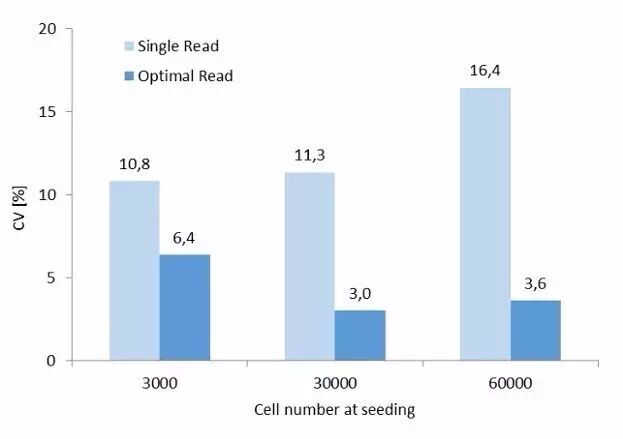Detecting differences in cell fluorescence experiments requires high detection sensitivity and reproducibility provided by high quality optics and intelligent assays. All of the above goals can be achieved with the SparkTM multi-function microplate reader.

Compared to Single Read (48-well plate), Optimal Read has higher repeatability (low coefficient of variation).
Fusion optics allow you to quickly locate to the right wavelength
Choosing the optimal excitation and emission wavelengths is the basis for successful fluorescence detection. The multi-function microplate reader comes with a filter or monochromator (MCR) that selects the appropriate excitation and emission wavelengths for fluorescent applications. MCR allows you to precisely select the wavelength you need to bring great flexibility to a range of applications. Currently only MCR supports accurate spectral scanning in a few small steps. However, the MCR transmittance is lower than the filter, which causes a decrease in sensitivity. Filter-based microplate readers have higher sensitivity, but are only suitable for pre-defined wavelengths and are therefore only suitable for specific inspection applications.
The hybrid system combines the flexibility of MCR and filters, but limits the MCR or filter selection for a single experiment. Now, the Spark Multi-Function Labeler's unique Fusion Optics allows you to combine MCR and filters in the same experiment to truly achieve optimal wavelength selection for maximum sensitivity. This means that we can select the filter at the excitation end and the MCR at the transmitter end, and vice versa. This unique ability to combine MCR flexibility with filter sensitivity is ideal for fluorescence emission or excitation scanning. The new SparkControlTM software makes MCR or filter wavelength selection easier.
Precision focus, continuous maintenance.
Once the optimal excitation and emission wavelengths have been determined, the next step is to ensure that the signal is measured at the appropriate location. The Spark microplate's Z-axis autofocus feature automatically determines the focus, ensuring the highest signal-to-noise ratio for each plate hole, independent of plate type, hole pattern or sample volume. This means that you can avoid the background interference signal of the medium by measuring only your own cell layer signal to get the best results. The Z-axis autofocus feature allows you to accurately measure each hole in each board.
Maximize coverage and operate efficiently.
Now you can get high-sensitivity fluorescence measurements from the cell layer in the culture well. But you also need to make sure that you are measuring the entire cell culture surface. After all, many types of cells are prone to uneven growth at the bottom. Many microplate readers can read multiple times for each well, but this method usually requires manual input by the user, and the input mode varies depending on the plate type. In addition, the number of scans is often fixed, and it is often time consuming if you want to increase the coverage of the hole bottom.
But Spark's unique Optimal Read Function ensures you get great cell culture coverage quickly. The holes are evenly illuminated during excitation and full hole emission. This ensures that you can reliably and reproducibly analyze the homogeneous cell layer by measuring the points distributed on each well multiple times. This process is very fast because the number of scans is automatically assigned at each measurement point. The measured results are individual values ​​for each well of a 6-384 well plate, and the repeatability coefficient of variation can be improved by up to four times.
Standardized convergence level
The final modification can now be complemented by standardizing cell confluence levels to map the curve and remove any factors that might interfere with the interpretation of the results. The Spark Cell Imaging Module allows you to accurately determine the level of confluence within a well (10-90%), which can significantly improve data quality. This convergence analysis is combined with the Optimal Read Function to create a system that is closer to the imaging system.
A flexible multi-function microplate reader that improves detection performance
The Spark multi-function microplate reader also has many other functions. The HD Orifice Scan feature can be used to obtain qualitative images of fluorescently labeled cell populations in a microplate, as well as to create low-resolution well-plate fluorescence images. Environmental control ensures that cell cultures remain healthy during long trials; activity analysis and live cell imaging are used to monitor and analyze your cells.
No matter what you do, the Spark Multi-Function Microplate Reader takes your fluorescent cell detection to the next level.
Rape Seeds,Oil Seed Rape,Colza Seeds,Rapeseed Seeds
XIKE AGRICULTURAL GROUP CO . .LTD. , https://www.laoseed.com